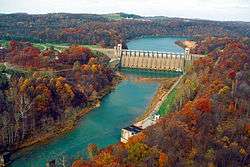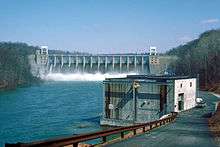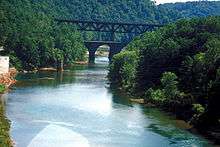Conemaugh River
The Conemaugh River is a 70-mile (110 km) long tributary of the Kiskiminetas River in Westmoreland, Indiana, and Cambria counties in the U.S. state of Pennsylvania.[2] It crosses both the Pittsburgh metropolitan area and the Johnstown, Pennsylvania metropolitan area. The name means 'Otter Creek', originating from the Unami-Lenape language word kwənəmuxkw 'otter'.[3][4][5]
| Conemaugh River | |
|---|---|
 Conemaugh River Lake Dam at low water | |
| Location | |
| Country | United States |
| Physical characteristics | |
| Source | |
| • coordinates | 40.3317406°N 78.9250255°W |
| Mouth | |
• coordinates | 40.4856220°N 79.4539299°W |
• elevation | 827 ft (252 m) |
| Discharge | |
| • location | Tunnelton |
| • average | 2,431 cu ft/s (68.8 m3/s)[1] |
| Basin features | |
| River system | Allegheny River |
Course

The Conemaugh River is formed at Johnstown (site of the Johnstown Flood) in southwestern Cambria County by the confluence of the Little Conemaugh and Stonycreek rivers. It flows generally WNW, in a winding course through the mountains along the northern edge of Laurel Hill and Chestnut Ridge. Northwest of Blairsville it is joined by Blacklick Creek. At Saltsburg it is joined from the south by Loyalhanna Creek to form the Kiskiminetas River. Along much of its lower course, the Conemaugh forms part of the boundary between Westmoreland and Indiana counties.
Watershed

The Kiskiminetas-Conemaugh river basin flows through scenic mountainous country that forms the heart of the historic coal-producing areas of western Pennsylvania. Before the Dam was constructed, the town of Livermore served the area between Blairsville and Saltsburg as an important stop along the former canal, as well as the railroad. The watershed is considered among the most degraded in the state, largely from abandoned mine drainages. The recovery of the river has been an important ongoing ecological management project of state and private agencies.
References
- https://waterdata.usgs.gov/pa/nwis/annual/?format=sites_selection_links&search_site_no=03044000&agency_cd=USGS&referred_module=sw
- "Conemaugh River". Geographic Names Information System. United States Geological Survey. Retrieved 2011-04-27.
- Linder, Lee (Jul 9, 1970). "Happenings in Pennsylvania". Observer-Reporter. pp. B3. Retrieved 23 May 2015.
- Storey, Henry Wilson (1907). History of Cambria County, Pennsylvania. 1. New York: Lewis. p. 63. Retrieved June 10, 2016.
- "kwënëmuxkw". Lenape Talking Dictionary. Archived from the original on February 1, 2016. Retrieved June 10, 2016.